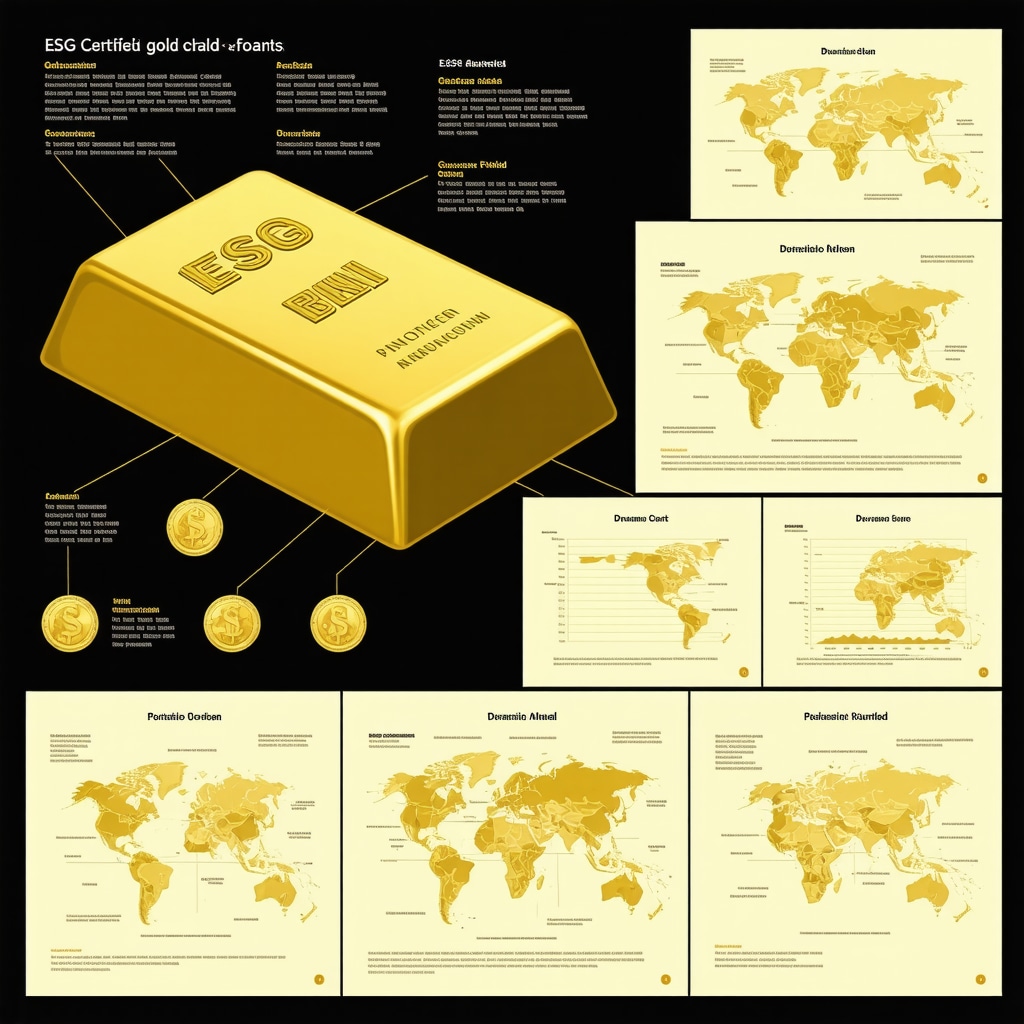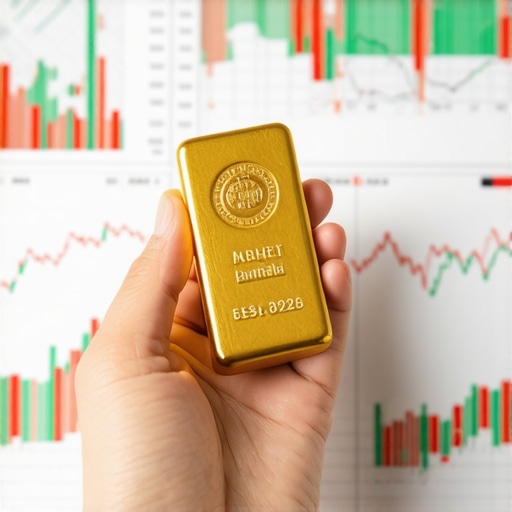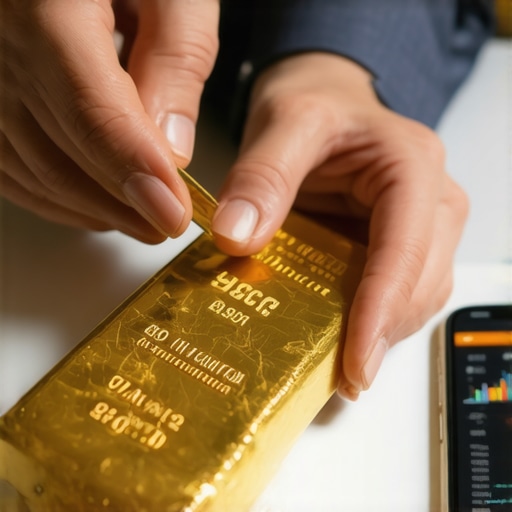Unlocking the Golden Gateway: Why Start Investing in Gold?
For beginners stepping into the investment arena, gold offers a timeless allure that transcends market volatility and economic uncertainty. Unlike stocks or bonds, gold has preserved wealth across centuries, making it a compelling cornerstone for building a solid portfolio. But how does one navigate this glittering yet complex market? Understanding gold’s unique role in diversification and its hedge against inflation is the first step toward mastery.
Weaving Your Portfolio with Gold: Strategies Tailored for New Investors
Building a gold investment portfolio isn’t about plunging blindly into bullion or ETFs; it requires a nuanced approach that balances risk, liquidity, and long-term growth. Beginners should consider a mix of physical gold—such as coins and bars—and gold-backed securities to optimize stability and returns. For instance, incorporating gold IRAs can provide tax advantages while securing retirement wealth.
What Are the Essential Factors to Evaluate Before Buying Gold?
Before acquiring gold, ask yourself: What is the purpose of this investment? Are you hedging against inflation, seeking capital appreciation, or diversifying risk? Additionally, consider the purity, authenticity, and provenance of physical gold, as well as the expense ratios and liquidity of gold ETFs or mutual funds. It’s crucial to understand the supply-demand dynamics driving gold prices, as explored in this detailed analysis. This knowledge empowers informed decisions and mitigates common pitfalls.
Practical Wisdom: Real-World Examples Illuminating Gold Investment Decisions
Take, for example, the 2008 financial crisis when gold prices surged while equities plummeted. Investors who had allocated even a modest share to gold experienced relative portfolio stability. Another scenario involves geopolitical tensions, where gold often acts as a safe haven. These cases highlight gold’s strategic value beyond mere asset class—it is a shield in turbulent times. Beginners can emulate this by gradually increasing gold allocations aligned with their risk tolerance and market outlook.
Navigating the Maze: Avoiding Pitfalls and Scams in Gold Buying
With gold’s rising popularity, the risk of counterfeit products and unscrupulous dealers has grown. New investors must prioritize buying from reputable sources and verify authenticity rigorously. Resources like this comprehensive guide offer expert tips to ensure safe transactions. Moreover, understanding the storage and insurance aspects of physical gold protects your investment from theft or loss.
Expanding Horizons: How Gold ETFs and Mutual Funds Can Enhance Your Portfolio
For beginners wary of handling physical gold, gold ETFs and mutual funds provide accessible alternatives with the benefits of liquidity and professional management. These instruments allow you to tap into the gold market without the challenges of storage or authenticity verification. Expert analyses, such as those found in this insightful article, reveal how these funds can fit various investment strategies and risk profiles.
Ready to Shine? Share Your Gold Investment Journey and Questions
Embarking on your gold investment journey is both exciting and empowering. Have you started building your gold portfolio, or are you weighing your options? Share your experiences and questions in the comments below to join a community of savvy investors. Also, explore more expert strategies on investing in gold for beginners to deepen your understanding.
For authoritative insights on gold’s role in global economics, the World Gold Council offers comprehensive research and data, trusted by investors worldwide.
Balancing Physical Gold and Digital Investments: My Personal Approach
Over the years, I’ve found that blending physical gold ownership with digital gold investments offers a balanced strategy. Physical gold, like coins and bars, gives me a tangible sense of security—there’s something reassuring about holding a piece of precious metal that’s been valued for centuries. However, I also appreciate the convenience and liquidity of gold ETFs and mutual funds, which allow me to respond swiftly to market changes without worrying about storage or authenticity.
One lesson I learned from experience is the importance of not putting all your eggs in one basket. For beginners, starting with a small allocation in physical gold, then gradually adding ETFs as you become more comfortable, can build confidence and diversify risk effectively. If you’re curious about the nuances of these options, this guide comparing physical gold and gold ETFs is a fantastic resource that helped me understand the pros and cons in detail.
How Do Macro Trends Influence Your Gold Investment Decisions?
Every investor should keep an eye on global economic factors that affect gold prices. For example, inflation rates, currency fluctuations, and central bank gold purchases can all drive market movements. Personally, I track these indicators regularly, often referring to trusted analyses like those from the World Gold Council, which provides comprehensive, data-driven insights.
During periods of economic uncertainty or geopolitical tension, I tend to increase my gold holdings, viewing it as a hedge against volatility. Conversely, when markets are stable and inflation is low, I might reduce exposure slightly to capitalize on other growth opportunities. This flexible approach, informed by macro trends, has helped me navigate the often unpredictable gold market with more confidence.
Have You Considered How Your Investment Goals Align with Gold’s Unique Characteristics?
Reflecting on why you want to invest in gold can clarify your strategy. Are you seeking long-term wealth preservation, short-term gains, or portfolio diversification? Understanding this helps determine whether to focus on physical gold, ETFs, or a combination. I found that setting clear goals early on made my investment decisions more purposeful and less reactive to market noise.
Engage With Fellow Investors: Share Your Gold Investment Stories
Gold investment is a journey filled with learning curves and rewarding discoveries. If you’ve started your own path or are contemplating it, I invite you to share your experiences and questions in the comments below. Hearing diverse perspectives enriches our community and helps everyone make smarter, more informed choices. Plus, if you want to deepen your knowledge, check out this beginner-friendly guide that offers practical tips and confidence-building strategies.
Decoding Gold’s Complex Price Drivers: Beyond the Basics
While many investors recognize gold as a safe haven during economic turmoil, the intricate forces shaping its price movements often remain elusive. Gold prices are influenced by a multifaceted interplay of supply constraints, geopolitical events, monetary policy shifts, and investor sentiment. For example, central bank actions—such as quantitative easing or interest rate adjustments—can dramatically sway gold’s appeal as an alternative asset. Furthermore, mining production fluctuations and recycling rates subtly alter supply dynamics, creating nuanced ripple effects in pricing.
To truly master gold investing, one must delve into these macro and microeconomic drivers with precision. Monitoring data releases from authoritative entities like the World Gold Council’s Market Data reveals real-time trends in demand from sectors such as jewelry, technology, and investment. This granular insight equips investors to anticipate price shifts rather than merely react, fostering a proactive investment posture.
How Can Sophisticated Investors Utilize Derivatives to Amplify or Hedge Gold Exposure?
Advanced market participants often incorporate derivatives like gold futures, options, and swaps to tailor their exposure and manage risk. Futures contracts enable locking in prices for physical gold delivery at a future date, instrumental for hedging against adverse price moves or speculating on directional trends. Options provide asymmetric risk profiles, offering the right but not obligation to buy or sell gold at predetermined prices, a powerful tool for leveraging market volatility.
However, derivatives entail complexity and elevated risk, demanding robust understanding and vigilant management. They can magnify gains but also exacerbate losses, especially in volatile markets. Therefore, integrating derivatives should align with clearly defined investment objectives and risk tolerance, ideally under guidance from market experts or seasoned advisors.
Integrating ESG and Ethical Considerations into Gold Investment Strategies
As environmental, social, and governance (ESG) factors gain prominence, gold investors increasingly scrutinize the ethical footprint of their holdings. Mining practices have come under fire for environmental degradation and human rights concerns, prompting demand for responsibly sourced gold. Investors can now access certifications like the Responsible Jewellery Council (RJC) or Fairmined labels, which verify adherence to stringent sustainability and ethical standards.
Moreover, ESG-focused gold ETFs and mutual funds have emerged, combining financial returns with social responsibility. By selecting these vehicles, investors not only safeguard their portfolios but also support positive industry transformation. This intersection of profit and principle exemplifies the evolving sophistication of modern gold investment strategies.
Optimizing Portfolio Allocation: Dynamic Gold Weighting Based on Economic Cycles
Strategically adjusting gold allocations in response to economic cycles can enhance portfolio resilience and optimize returns. During inflationary phases or geopolitical instability, increasing gold exposure often mitigates downside risk due to its non-correlated nature and intrinsic value. Conversely, in periods of robust economic growth and stable monetary policy, reducing gold weighting in favor of higher-yielding assets may be prudent.
Implementing a dynamic allocation model requires continuous market analysis and willingness to rebalance, which can be facilitated by algorithmic tools or professional portfolio management. This approach transcends static allocation methods, aligning investment posture with prevailing macroeconomic realities for sustained portfolio health.
What Are the Tax Implications and Regulatory Nuances for Gold Investments Across Different Jurisdictions?
Tax treatment of gold investments varies widely by country and instrument, impacting net returns significantly. For instance, physical gold may be subject to capital gains tax, value-added tax (VAT), or import duties depending on local laws. Gold ETFs or mutual funds might offer different tax advantages or disadvantages, especially when held within retirement accounts or specific investment vehicles.
Investors must familiarize themselves with pertinent regulations, reporting requirements, and possible tax optimization strategies to avoid unexpected liabilities. Consulting with tax professionals who specialize in precious metals is highly recommended to navigate this complex landscape efficiently.
For deeper exploration of these advanced gold investment facets, consider engaging with specialized expert resources or certified financial advisors well-versed in precious metals markets. Your journey toward sophisticated gold investing starts with continuous learning and strategic action.
Elevating Your Gold Strategy with ESG Principles: Aligning Wealth and Responsibility
As the investment landscape increasingly prioritizes sustainability, discerning investors are integrating Environmental, Social, and Governance (ESG) criteria into their gold acquisition strategies. This approach transcends mere profit, emphasizing the importance of sourcing gold that upholds environmental stewardship and social justice. Certifications such as the Responsible Jewellery Council (RJC) and Fairmined labels serve as essential benchmarks, ensuring that gold mining adheres to ethical labor practices and minimizes ecological impact. By incorporating ESG-compliant gold ETFs and funds, investors can contribute to industry transformation while safeguarding their portfolios against reputational and regulatory risks.
Adaptive Gold Allocation: Harnessing Economic Cycles for Portfolio Optimization
Dynamic portfolio management advocates for adjusting gold exposure in consonance with macroeconomic fluctuations. During inflationary surges or geopolitical unrest, augmenting gold holdings can act as a bulwark against volatility, given gold’s historically uncorrelated behavior with equities and bonds. Conversely, in phases of economic expansion with stable interest rates, a calibrated reduction in gold allocation can unlock higher growth potential through equities or alternative assets. Implementing this fluid strategy demands rigorous market analysis, often enhanced by algorithmic tools and professional portfolio oversight, enabling investors to synchronize their gold weighting with prevailing economic signals effectively.
What Are the Critical Tax Considerations for International Gold Investors Navigating Diverse Jurisdictions?
Taxation on gold investments is a labyrinthine domain, varying extensively across countries and investment vehicles. Physical gold may incur capital gains tax, Value-Added Tax (VAT), or import tariffs, while gold-backed ETFs might enjoy favorable tax treatment, especially within retirement accounts. For example, in the United States, physical gold is treated as a collectible subject to distinct capital gains rates, whereas in the United Kingdom, certain gold investments are exempt from capital gains tax. These discrepancies necessitate a comprehensive understanding of local regulations and strategic tax planning to optimize net returns and ensure compliance. Engaging with tax advisors specializing in precious metals is indispensable for navigating these complexities.
Leveraging Authoritative Data: The World Gold Council as a Premier Resource
For investors committed to mastering gold markets, the World Gold Council stands as an unparalleled resource. Their extensive datasets, rigorous market analysis, and ESG reporting provide invaluable insights into demand-supply dynamics, price drivers, and sustainability trends. Utilizing such data empowers investors to formulate informed strategies rooted in empirical evidence rather than speculation.

Call to Action: Engage with Advanced Gold Investment Strategies Today
Elevate your investment acumen by integrating ESG considerations, mastering tax implications, and adopting dynamic allocation methodologies in your gold portfolio. Connect with specialized advisors and leverage authoritative data to transform your gold investment approach from reactive to proactive. Share your advanced strategies and queries below to join a community of sophisticated investors dedicated to navigating gold markets with expertise and foresight.
Frequently Asked Questions (FAQ)
What is the safest way for a beginner to start investing in gold?
For beginners, starting with a diversified approach that includes both physical gold (such as coins or bars from reputable dealers) and gold-backed ETFs or mutual funds is advisable. Physical gold offers tangible security, while ETFs provide liquidity and ease of trading. Prioritize authenticity verification and consider storage and insurance for physical holdings.
How do economic cycles influence optimal gold allocation in a portfolio?
Gold allocation should be dynamic, increasing during inflationary periods, geopolitical unrest, or market volatility to hedge risk. Conversely, during stable economic growth with low inflation, a reduced gold weighting may improve returns by favoring higher-yielding assets. This strategy requires ongoing market analysis and flexible portfolio rebalancing.
What are the key ESG factors to consider when investing in gold?
ESG considerations include sourcing gold from mines that adhere to environmental stewardship, responsible labor practices, and governance standards. Certifications like the Responsible Jewellery Council (RJC) and Fairmined labels validate these criteria. ESG-compliant gold ETFs and funds allow investors to align ethical values with financial goals.
Can derivatives be effectively used to manage gold investment risk?
Yes, sophisticated investors use gold futures, options, and swaps to hedge exposure or speculate. These instruments offer leverage and flexibility but carry significant risk and complexity. Proper understanding and professional guidance are essential to avoid amplified losses.
How do tax regulations affect gold investment returns internationally?
Tax treatment varies by jurisdiction and investment type. Physical gold may be subject to capital gains tax, VAT, or import duties, while gold ETFs might have different tax benefits, especially within retirement accounts. Investors should consult local tax laws and professionals to optimize tax efficiency and ensure compliance.
What role does the World Gold Council play for gold investors?
The World Gold Council offers authoritative market data, research on supply-demand dynamics, pricing drivers, and ESG trends. Investors rely on their insights for informed decision-making and to monitor global gold market developments.
Is holding physical gold better than investing in gold ETFs?
Both have merits: physical gold provides tangible ownership and a hedge against systemic risks, while ETFs offer liquidity, ease of access, and no storage concerns. A blended approach tailored to risk tolerance and investment goals is often optimal.
How can I verify the authenticity of physical gold purchases?
Buy from reputable dealers, request certification or assay reports, and consider independent third-party verification. Familiarize yourself with hallmarking standards and use professional appraisal services if needed to avoid counterfeits.
What strategies help beginners avoid scams in gold investment?
Research dealers carefully, avoid deals that sound too good to be true, verify product authenticity, and use secure payment methods. Educational resources and guides from trusted organizations can enhance vigilance and confidence.
How does inflation impact gold prices?
Gold traditionally acts as a hedge against inflation because its value tends to rise as currency purchasing power declines. During inflationary periods, demand for gold usually increases, pushing prices higher.
Trusted External Sources
- World Gold Council (https://www.gold.org/): The premier authority on gold market data, offering comprehensive research on price drivers, investment demand, and ESG initiatives, crucial for informed gold investment strategies.
- Responsible Jewellery Council (https://www.responsiblejewellery.com/): Provides certification and standards for ethical gold sourcing, essential for investors prioritizing ESG compliance.
- International Monetary Fund (IMF) Precious Metals Reports: Delivers macroeconomic analyses and data on gold reserves, central bank activity, and global monetary policy impacts affecting gold markets.
- Bloomberg Precious Metals Section: Offers timely market news, price trends, and expert commentary valuable for tracking gold’s real-time market dynamics.
- OECD Tax Database: Valuable resource for understanding tax regulations and implications of gold investments across different jurisdictions.
Conclusion
Mastering gold investment requires a sophisticated understanding of its multifaceted role as a wealth preserver, inflation hedge, and portfolio diversifier. This article has illuminated essential factors from dynamic allocation strategies aligned with economic cycles, to integrating ESG principles that reconcile ethical responsibility with financial objectives. Recognizing the nuances of tax implications and the prudent use of derivatives further elevates one’s investment sophistication. Trusted data from authoritative sources like the World Gold Council empower investors to anticipate market shifts proactively rather than reactively. Whether through physical gold, ETFs, or advanced instruments, a balanced, flexible approach tailored to personal goals and risk tolerance is paramount.
Embark confidently on your gold investment journey by applying these expert insights and strategies. Engage with the community by sharing your perspectives and questions, and explore additional expert content to deepen your mastery of this timeless asset.











This article brilliantly highlights the importance of a balanced approach to gold investing, especially for beginners. I’ve personally found that starting with a small allocation in physical gold, like coins, gave me a tangible sense of security. However, as I grew more comfortable, incorporating gold ETFs provided much-needed liquidity and flexibility to adjust my portfolio without hassle. What really resonated with me is the emphasis on understanding the purpose behind the investment — whether to hedge against inflation, seek capital appreciation, or diversify risk. This clarity helped me avoid impulsive decisions during market fluctuations. One challenge I’ve faced is navigating the abundance of gold dealers and ensuring authenticity; trustworthy sources are paramount. Given the evolving landscape, how are others balancing ESG considerations when selecting gold investments? Are there specific resources or certifications that you’ve found valuable in aligning ethical values with financial goals? I’d love to hear how fellow investors integrate these factors while building their gold portfolios.
Reading through this comprehensive guide on beginning gold investments really reinforced the importance of setting clear objectives before diving into this asset class. I particularly appreciated the emphasis on diversification between physical gold and ETFs, which aligns with my approach to managing risk and liquidity. My personal experience confirms that starting with a small, tangible holding helps build confidence, especially when verifying authenticity and understanding storage options. I’ve also been exploring how macroeconomic factors influence gold prices; staying informed about inflation trends and geopolitical tensions has helped me adjust my allocations proactively. The idea of integrating ESG principles resonates with me too, as responsible sourcing is becoming more accessible with certifications like RJC and Fairmined. How do others balance the weight of these ethical factors versus potential returns? Do you think ESG-certified gold truly impacts long-term performance? I believe combining ethical considerations with solid financial goals creates a more sustainable investment strategy and would love to hear others’ insights on this aspect.